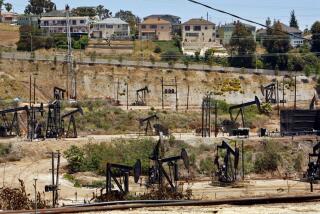Offshore Oil Production
Your editorial (Sept. 11), âShattered Trust,â contains a key statement that ought to be understood by everyone who cares about the California coast. You said, âand while California is contributing its share of oil production, including the offshore region, the state will have to live with some more offshore rigs at some point.â
Truly everyone who studies this matter eventually reaches the same conclusion: America sooner or later will need this resource. Estimates are that there are anywhere from 1 to 3 billion barrels of oil in the areas that are presently off limits to drilling because of the moratorium.
No one can tell us what is really there until there is exploration (geological and geophysical) and drilling. But these estimates will continue to be a powerful draw to those who seek to reduce Americaâs dependence upon foreign suppliers of oil.
Also, it has been established beyond any doubt that only a few of the tracts, even in the best areas, will prove to have oil. The federal government has offered for lease 1,562 tracts off California in the past. Of these, 420 have been bid upon, 312 have been leased, 121 have been explored (by drilling) and only 38 have been developed through the construction of 18 drilling platforms off the California coast in federal waters. Areas presently leased off California, assuming the necessary permits will be obtained, are believed eventually to require a maximum of 31 production platforms with about 760 wells. (This compares to 3,500 wells on 13 platforms and islands that already are in state waters.)
You have said in effect that the day will come when the area in moratorium must be producing oil for America. You are right. All of us who care about the scenic and environmental values of the California coast ought to be concerned that when that exploration and development takes place it be done in an orderly and environmentally sensitive manner. That is precisely what is required and is being done under the existing law, the 1978 Outer Continental Shelf Lands Act amendments.
But to blindfold America now, to impose a moratorium at a time when geologists believe there is vast potential off this coast, is to invite a panic reaction in the next oil crisis. We run the risk that Americans in a panic will sweep aside environmental and aesthetic concerns and plunge ahead in a mad rush for oil. Anyone who thinks that this could never happen only needs to think back to the inhumane actions toward Japanese-Americans following Pearl Harbor to realize that nothing is safe when there is panic.
I believe that these considerations suggest that now is the time to approach these areas in an orderly, careful way. Now is the time we can impose proper safeguards and appropriate restraints. We are willing and able to do so in the present atmosphere. How much better this is than to risk a sudden, uncaring rush to production driven by public outcries at the time of the next oil cutoff.
Several members of the California delegation who have been the loudest in denouncing me for backing out of a âdealâ have acknowledged clearly that this proposal was âpreliminary,â and one of them proclaimed it a âlandmark.â Recently they have acted as if they have forgotten the word âpreliminaryâ and have stridently accused me of having called it a âlandmarkâ at that time. The record does not seem to support that accusation.
I will not let such manipulations force me into a final agreement that is not in the national interest. By the same token, my ongoing belief that America and California will be better served by consultation and consensus than by confrontation will cause me to keep my door open for any proper way to resolve the key issues and move forward with a program that is orderly, environmentally sound and, therefore, truly in everyoneâs best interests.
DONALD PAUL HODEL
Secretary of the Interior
Washington, D.C.
More to Read
Sign up for Essential California
The most important California stories and recommendations in your inbox every morning.
You may occasionally receive promotional content from the Los Angeles Times.










